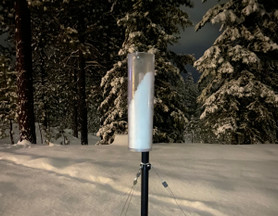Posted by Climalytic Instruments, LLC on 7th Dec 2023
TROPO Tips & Tricks for Winter
TROPO Features for Snow
- If you haven’t used the handle yet, you’ll find it really helpful for making snow measurements, particularly for making core samples of the snow and handling the cold, wet and slippery gauge.
- The pour spout atop the outer tube makes it much easier to decant the melted snow into the inner tube for making precise measurements.
- You’ll find the mounting bracket won’t seize-up during freezing conditions, making it easy to dismount and remount.
- The high-capacity TROPO gauge provides accurate catchment of snow falls up to 12 inches.
- The funnel-like top to the inner tube makes it easy to pour in melted snow without spilling.
TROPO Features for Snow
- Be sure to remove the cap/funnel and inner tube from your gauge during snowfall events. This will allow the gauge to freely capture wintry precipitation without accumulating on top of the gauge. Our tests have shown the inner tube to be resilient to cracking under the pressure of expanding ice when the inner tube is filled with water, so if you live in a place with infrequent winter precipitation, but occasional sub-freezing temperatures, you can leave the cap/funnel and inner tube in place.
- Do NOT use the measurement labels on the outer tube for determining the depth of fresh/new snowfall/sleet/ice, instead make a number (5-10) of snowfall measurements using a ruler or measuring stick on a snow measurement board or other level, undisturbed surface to compute a representative average fresh snowfall depth. For determining the fresh/new snow water equivalent (SWE), gather a snow core sample of the fresh/new snow with the outer tube of the TROPO gauge at a location with the representative snow depth. Allow the snow to melt, then pour it carefully into the inner tube to compute the SWE.
- SWE can also very easily and accurately be determined by weight. When the outer tube contains snow, weigh it and subtract the dry weight of the tube to determine the weight of the snow. To compute the SWE, take the weight of snow in grams and divide it by 206g or weight in ounces divided by 7.27oz. For example, if the snow weighed 80g (2.8oz), the SWE would be 80g/206g or 2.8oz/7.27oz which both equate to 0.39 inches (9.9mm). We recommend this affordable and CoCoRaHS approved scale.
- CoCoRaHS offers several excellent videos on snow measurements.
- If you want even more information about the science, climatology and measurement of Snow, check out Nolan Doesken’s book: “The Snow Booklet: A Guide to the Science, Climatology & Measurement of Snow in the United States”.
Extra Tips for Measuring Snow
- Pour a premeasured amount of warm water into the outer tube containing snow/ice/sleet to expedite the melting process. Remember to subtract the amount of warm water added from the total for determining the SWE. Avoid using boiling hot water as the sudden change in temperature could crack the plastic.
- It is very handy having an extra outer TROPO tube for making snow core samples, while leaving the mounted gauge in place for measuring the “gauge catch.” A second outer tube is also handy for swapping out with the mounted gauge to allow the snow/ice to melt in one tube, while the other remains outside collecting new snow/ice.
- If you plan to use a scale to determine the precipitation (liquid equivalent of melted snow, ice, sleet, freezing rain), use a scale to determine the dry weight of the outer tube. With a permanent marker, write the weight on the bottom of the outer tube for future reference.

